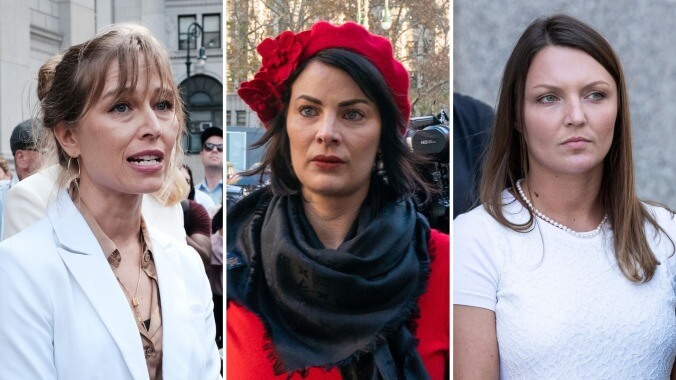For years, public discussion of the Jeffrey Epstein criminal case has unfolded in headlines, hearings, and documentaries. Yet despite the global attention, the individuals harmed by Epstein’s network—the young women and girls whose futures were reshaped by trauma—remain too often eclipsed by the spectacle surrounding the case. Today, as civil suits and investigations continue, advocates argue that bringing more attention to these survivors is not only a moral imperative but a pathway to lasting reform.
“People remember the photos of mansions and private jets; they don’t remember the faces of the girls who were groomed and exploited,” says Maya L., a survivor advocate who has worked directly with several women connected to the case. “It’s time to shift the spotlight.”
The Challenge of Competing Narratives

From left, Annie Farmer in 2022, Sarah Ransome in 2021, and Courtney Wild in 2019. Photos: Getty Images
Much of the public conversation around Epstein has centered on his social circle and the powerful figures who may have been connected to him. The names of politicians, celebrities, and billionaires often dominate coverage, overshadowing the experiences of the survivors.
This imbalance has consequences. When attention tilts toward speculation, conspiracy, or scandal, the human impact gets lost. Trauma-informed media reporting—now widely recognized as best practice in cases of sexual abuse—prioritizes survivor experiences, uses careful language, and avoids sensationalism.
Instead, too many stories have led with intrigue rather than the voices of those harmed.
“Every time a headline focuses on who might have flown on a plane instead of what these girls endured, it tells survivors that their pain is secondary,” notes Dr. Alina Perez, a clinical psychologist specializing in trauma and exploitation.
Breaking the Silence: Survivor-Led Storytelling

In recent years, several survivors have chosen to speak publicly. Their accounts—courageous, painful, and essential—reveal not just individual experiences but systemic patterns of grooming, manipulation, and institutional failure.
Yet many survivors still struggle for space in mainstream coverage.
 Advocacy organizations recommend creating more opportunities for survivor-led storytelling: editorial partnerships, podcasts, public forums, and op-eds authored by survivors themselves. Not every survivor wants to speak, and not every survivor should feel pressure to. But those who do choose to share deserve platforms that center their perspectives rather than using their stories as supporting details to a broader narrative.
Advocacy organizations recommend creating more opportunities for survivor-led storytelling: editorial partnerships, podcasts, public forums, and op-eds authored by survivors themselves. Not every survivor wants to speak, and not every survivor should feel pressure to. But those who do choose to share deserve platforms that center their perspectives rather than using their stories as supporting details to a broader narrative.
“We aren’t side characters in Epstein’s story. He’s the side character in ours,” one survivor said during a closed advocacy meeting shared with permission for publication but without attribution.
Connecting the Case to a Larger Crisis

The Epstein case is often portrayed as an outlier—a billionaire with a private island and a network of enablers. But researchers emphasize that the mechanisms of abuse involved are tragically common.
Grooming, coercion, financial vulnerability, emotional manipulation, and the complicity of institutions exist in countless exploitation cases across the country. Advocacy groups argue that centering survivors’ stories helps the public understand this broader reality.
A focus on the victims clarifies the systemic issues: law enforcement failures, lenient plea deals, prosecutorial discretion, and institutional negligence. These gaps allowed Epstein to operate for years despite repeated red flags.
“The Epstein case is not just about one predator. It’s about the cracks that predators slip through,” says Kendra Foster, policy director at the National Center for Youth Safety. “By listening to survivors, we learn where those cracks are.”
Transparency and Accountability Keep Attention Alive

Public attention fades when investigations stall or when processes are opaque. Survivors and advocates have long called for greater transparency into how Epstein’s network operated, why earlier investigations were dropped, and which institutions enabled the abuse.
Without transparency, survivors are left to question whether justice is truly possible.
Consistent reporting on investigations, civil suits, and accountability efforts helps maintain survivor visibility. Journalists can play a vital role by following paper trails, filing public records requests, and explaining legal developments in accessible terms.
The Long Shadow of Trauma

It is impossible to understand the full scope of the Epstein case without acknowledging the long-term trauma experienced by survivors. From mental health struggles to disrupted education and careers, the harm extends far beyond the years of direct abuse.
Survivors who testified in court described fear, shame, manipulation, and the lasting psychological impact of exploitation. These ongoing consequences deserve the same attention as the legal proceedings.
“People think the story ended when Epstein died. For the women he hurt, it didn’t end—it changed shape,” says Dr. Perez. “Healing isn’t linear. Public support helps.”
Moving Forward: A Collective Responsibility

Bringing more attention to the victims is not merely a media strategy—it is a public duty. It involves amplifying survivor voices, holding institutions accountable, advocating for policy reform, and educating the public on the realities of exploitation.
For advocacy organizations, this means expanding funding for trauma services, legal assistance, and survivor networks. For journalists, it means committing to sensitive, accurate, victim-centered reporting. For policymakers, it means enacting stronger protections against trafficking and ensuring oversight mechanisms are in place.
And for the public, it means refusing to let survivors’ stories disappear beneath headlines about wealth and scandal.
“Being heard is part of healing,” one survivor said during a recent victim impact statement. “We don’t want fame. We want recognition. We want to matter.”








